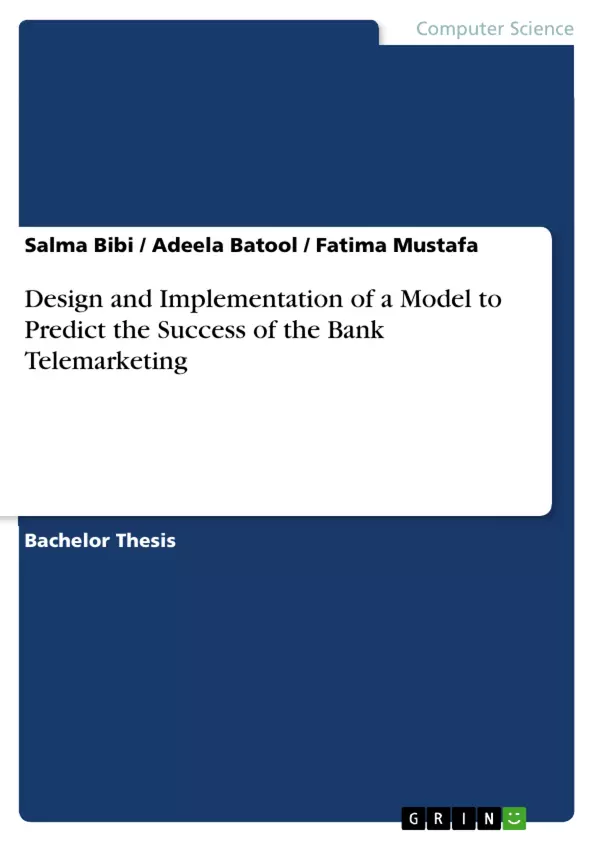Targeting customers is a major task of bank telemarketing to send their service to customers. Now banks are using a number of data mining techniques to predict the success rate. The Decision Tree is a successful data mining technique for predicting bank telemarketing success.
The Decision Tree is a well known classifier and is simple and easy to apply. The performance of decision trees can be improved with appropriate attribute selection. In this research, ID3 decision tree technique of data mining is applied on widely used benchmark data set. The main focus of this research was on designing and implementation of a model that predicts the success of bank telemarketing using decision tree technique of data mining.
Inhaltsverzeichnis (Table of Contents)
- INTRODUCTION
- 1.1 ID3 Algorithm:
- 1.2 Objective:
- 1.3 Problem Statement:
- 1.4 Project Scope:
- 1.5 Report Organization:
- LITERATURE REVIEW
- SYSTEM DESIGN
- 3.1 Introduction:
- 3.2 Proposed Model Design:
- 3.2.1 Logical Design (Flow Diagram):
- 3.2.2 Use Case Diagram:
- 3.2.3 Time Sequence Diagram...
- 3.2.4 Structural diagram:......
- IMPLEMENTATION
- 4.1 System Development Requirements:
- 4.1.1 Software Requirements:
- 4.1.2 Hardware Requirements:
- 4.2 Data Set Description:
- 4.2.1 Attribute Description:....
- 4.3 Decision Tree:.....
- 4.3.1 Decision Tree Algorithm:
- 4.3.2 Pseudo code:
- 4.3.3 Root node:
- 4.3.4 For further nodes (i.e. Internal and Leaf nodes): ..
- RESULTS
- CONCLUSION..............
- FUTURE WORK
- REFERENCES.
Zielsetzung und Themenschwerpunkte (Objectives and Key Themes)
The main objective of this research project was to design and implement a model that predicts the success of bank telemarketing campaigns using decision tree techniques. The model utilizes the ID3 algorithm and a widely used benchmark dataset.
- Predicting the success of bank telemarketing campaigns.
- Application of the ID3 decision tree algorithm.
- Data mining techniques for improving telemarketing efficiency.
- Analyzing and understanding bank telemarketing data.
- Developing a model to aid decision-making processes in bank telemarketing.
Zusammenfassung der Kapitel (Chapter Summaries)
The research project starts with a detailed introduction to the ID3 algorithm, outlining its purpose and relevance to the research. The objective and problem statement clearly define the scope of the project, focusing on the prediction of bank telemarketing success. Chapter 3 explores the system design, outlining the proposed model design, including logical design, use case diagrams, time sequence diagrams, and structural diagrams. The implementation chapter details the system development requirements, including software and hardware specifications. The data set description is further elaborated upon, providing insights into its attributes. The decision tree is examined in detail, covering the algorithm, pseudo code, and the structure of its nodes.
Schlüsselwörter (Keywords)
Key focus topics of this research include bank telemarketing, decision tree algorithms, data mining, ID3 algorithm, data analysis, predictive modeling, and telemarketing success prediction. The research utilizes a widely used benchmark dataset to develop a model that enhances decision-making processes in bank telemarketing by predicting customer responsiveness to telemarketing campaigns.
- Citar trabajo
- Salma Bibi (Autor), Adeela Batool (Autor), Fatima Mustafa (Autor), 2015, Design and Implementation of a Model to Predict the Success of the Bank Telemarketing, Múnich, GRIN Verlag, https://www.grin.com/document/310165



